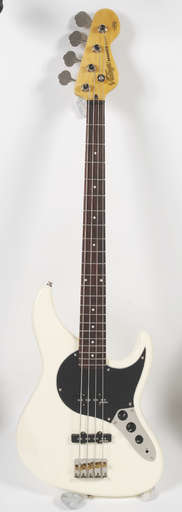MusicRadar Verdict
An excellent bass at a very affordable price.
Pros
- +
Modern twist on a classic design. Smooth jazzy sounds.
Cons
- -
The wider neck will surprise some players.
MusicRadar's got your back
When John Hornby Skewes decided to up the ante on its Vintage range of guitars and basses it needed someone with the knowledge and expertise in such matters - that man was Trev Wilkinson.
His accomplishments are well documented but for bass players he is probably best known for his Fret-King association and working alongside another legendary figure in the bass world, Michael Tobias.
As the general design of these two basses is obviously derived from a true classic Guitarist wondered what exactly was initially asked of him?
"There's been great commitment on JHS's part; costs come into it obviously but they've given me free reign and a clean sheet of paper and I'm glad to say it's paying off for them," Trev enthuses.
"The concept of the AV Series was nothing revolutionary, more a question of offering a different twist to a classic - like the higher neck access and that sort of thing," he continues.
"That's something we can do that our competitors like Fender and Gibson can't, otherwise it's not going to be a Fender Strat or a Gibson Les Paul any more."
Overview
Although this instrument has the closest associations with its design inspiration, the quest for improved string access has produced a sleeker, contemporary body shape.
To heighten this fresh approach the bass displays a radically different scratchplate. But what, if anything, has changed about the electronics?
"The four-string pickup is basically my take on a good sounding J-Bass," explains Wilkinson. "We're using the standard materials but generally using metric measurements.
"In the early days Fender polepieces were actually bigger than they were later on in the sixties when they dropped to 187 thousandths (4.7mm).
"Now, unless I had the Alnico ground down, I can't get that so we're using stock sized 5mm. Designing pickups around 5mm magnet slugs means you have to think a little more about the windings because, in my experience, if you want to keep the same tonality, there's a simple rule of thumb that whatever you do to a pickup you need to take everything else up or down in the same ratio.
"Pickups actually sound like they look so there's definitely a mechanical coupling, a physical part of it as well as an electronics part of it.
"So, if you increase the size of the magnet on a single-coil pickup you need to increase the wire coil size to the same ratio to keep the same tonality. If we went up in height and didn't go out in width we'd end up with a thinner sounding pickup."
Playing this bass produces a few surprises. For a start those deeper cutaways present the instrument to the player's body in a subtly different nature, but more important is the feel of the neck - where the P/J hybrid design shows its true colours.
The extra width is obviously most noticeable at the nut where it feels more like a P-Bass, but for the right hand this is all J-Bass - the designer's desired blend of the two has been achieved.
Sounds
The AV4 is an exceptionally smooth sounding instrument, and because of the circuit's passive nature there is the usual interaction between the volumes and the tone control.
So for the most dynamic blending of the pickups it's worth a little extra experimentation. There's also plenty of growl when you dig in - a very impressive sounding bass indeed.
“A synthesizer that is both easy to use and fun to play whilst maintaining a decent degree of programming depth and flexibility”: PWM Mantis review
“I feel like that song had everything we needed to come back with”: Bring Me The Horizon’s Lee Malia on Shadow Moses, its riff and the secrets behind its tone, and why it was the right anthem at the right time
“I said, ‘Are we sure we can write a song about death?’”: The story of Mike + The Mechanics' classic No.1 The Living Years










